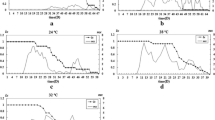Summary
Chelonus rufus Lyle is an egg larval parasite of the cotton bollwormEarias spp. in India. Investigations on the effect of temperature and humidity on the fecundity and longevity of the parasite have been studied.
-
(a)
Temperature has a profound influence on the fecundity, longevity and oviposition days of the parasite.
-
(b)
Maximum fecundity is obtained at 30°C., and lower and higher temperatures greatly reduced the number of eggs laid.
-
(c)
Optimum temperature for the longevity of the female is 25°C., though there is not significant difference between 25 and 30°C. in this respect. However, at 15°C., the longevity is increased to three times, but the fecundity is very much reduced. At 40°C. the longevity is about four times less than that at optimum temperature.
-
(d)
Daylight or darkness do not affect the fecundity.
-
(e)
Humidity and the interaction between relative humidity and temperature has no marked effect on both fecundity and longevity of the female.
Similar content being viewed by others
References
Ahmad, T. and Ghulamullah.. “Ecological studies on the spotted bollworm of cotton and their parasites. II. The fecundity and longevity ofEarias fabia and its parasiteMicrobracon greeni under different conditions of temperature and humidity,”Indian J. Ent., 1954,3, 245–384.
Andrewartha, H. G. and Birch. L. C.The Distribution and Abundance of Animals, University of Chicago Press, Chicago, 1941, pp. 782.
————— “Some recent contribution to the study of the distribution and abundance of insects,”Ann. Review Ent., 1960,5, 219–31.
Burnett, T... “The influence of natural temperature and controlled host densities on oviposition of insect parasite,”Physiol. Zool., 1954,27, 239–48.
Boxton, P. A... “The measurements and control of atmospheric humidity in nature to entomological problems,”Bull. Ent. Res., 1931,22, 431–47.
Frick, K. E., Simkover, H. G. and Telford, H. S. “Bionomics of the chemy fruit flies in Eastern Washington,”Tech. Bull. Wash. Agric. Exp. Sta., 1954,13, 2.
Madge, P. E. and Corne.. “The ecology ofOncopera fasciculata (Walker) (Lepd.: Hepiolidæ),”Australian J. Zool., 1956,4, 28–40.
Robertson & Sang.. “The Ceslogical determination of population growth in aDrosophila culture. Fecundity of adult flies.”Proc. Roy. Soc. Lond., Sr. B, 1944,132: 258–77.
Skoblo, I. S... “Ripening and fertility of females ofHabrobracon brevicornis Wesm. as dependent on development conditions during pre-imaginal stages,”C.R. Acad. Sci. U.R.S.S. (N.S.), 1941,6, 424–26.
Solomon, M. E... “Control of humidity with potassium hydroxide, sulfuric acid or other solutions,”Bull. Ent. Res., 1951,42, 543–54.
Vernon, H. S. and Ray, F. S... “Factors affecting egg production and oviposition in population ofColiasphilodice eurytheme Boisd.,”Hilgardia, 1960,29, 10.
Author information
Authors and Affiliations
Rights and permissions
About this article
Cite this article
Subba Rao, B.R., Gowda, G.K.V. Effect of temperature and humidity of the fecundity and longevity ofChelonus rufus lyle (Braconidae: Hymenoptera). Proc. Indian Acad. Sci. 54, 241–250 (1961). https://doi.org/10.1007/BF03051052
Received:
Issue Date:
DOI: https://doi.org/10.1007/BF03051052




